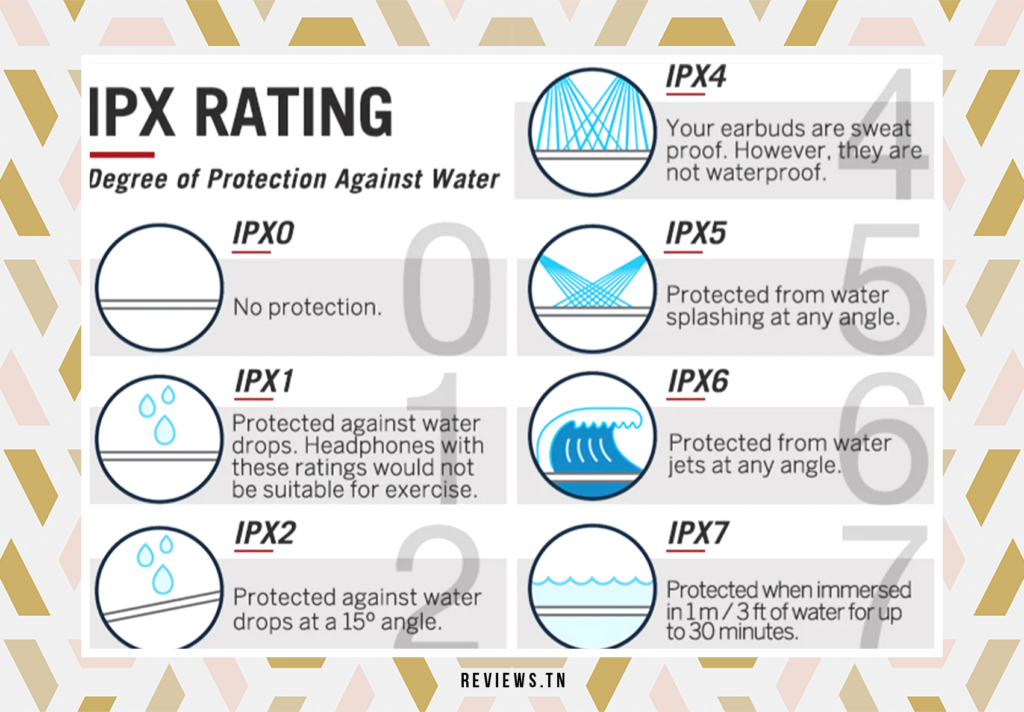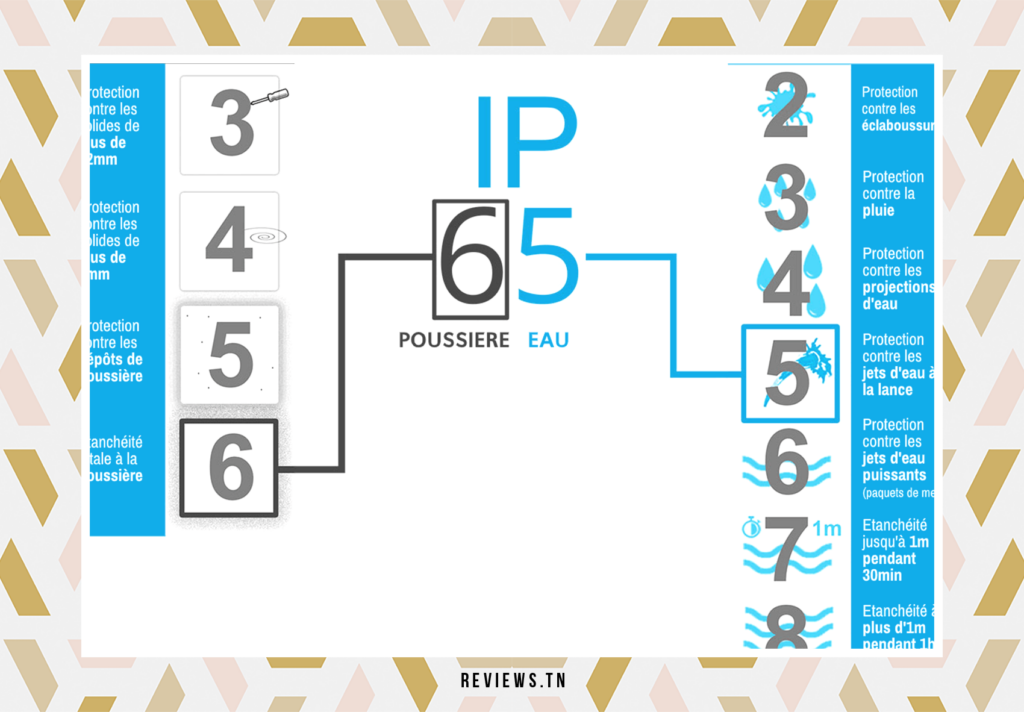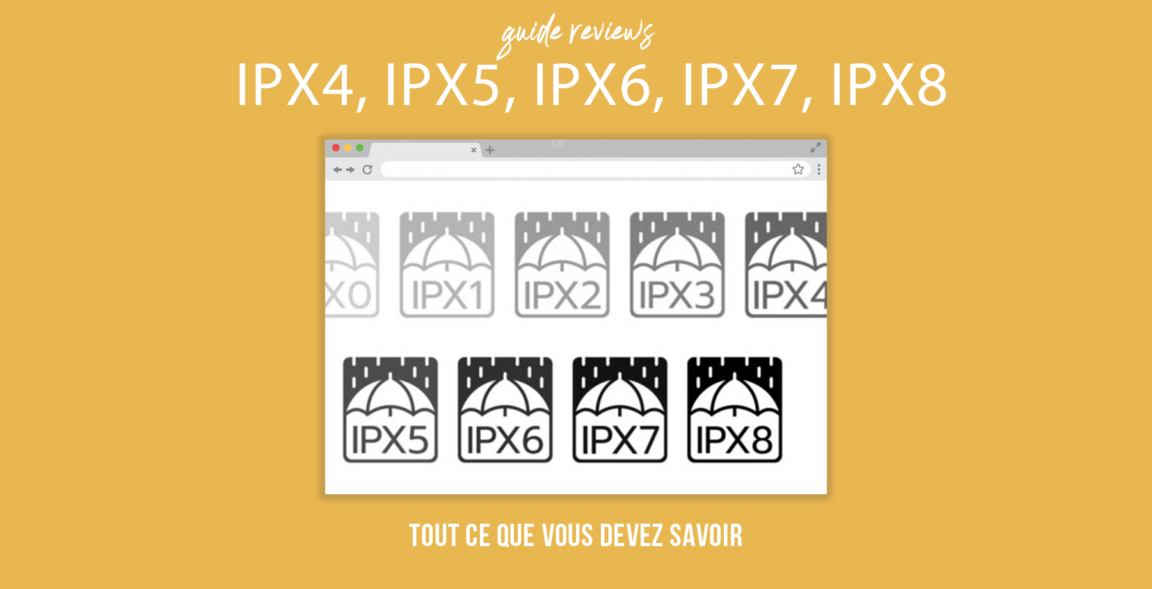Have you ever wondered why your cell phone is water resistant or why your Bluetooth speaker can survive an unexpected downpour? Well, the answer lies in the mysterious codes IPX4, IPX5, IPX6, IPX7 and IPX8! Don't worry, I'm here to enlighten you on these intriguing classifications. In this article, we'll delve into the fascinating world of water protection and find out what these codes actually mean. Fasten your seat belts, because we're about to navigate the oceans of water resistance standards.
Table of contents
Understanding the IP code: IPX4, IPX5, IPX6, IPX7, IPX8

Imagine yourself getting ready for a long day at work, your coffee in hand, and suddenly your precious smartphone takes an unexpected plunge into your cup. It's everyone's nightmare, isn't it? Well, that's where the IP code comes in.
The IP code, or Infiltration Protection Code, is an internationally accepted classification standard that gives you a clear idea of how well your device resists elements such as water and dust. When you understand these codes, you are better equipped to take care of your devices.
More and more devices, from smartphones to smartwatches, now sport an IP rating. But what do these numbers and letters that seem so enigmatic really mean? Allow me to enlighten you:
| IP code | Meaning |
|---|---|
| IPX4 | Can withstand splashing water from all directions. |
| IPX5 | Able to withstand low pressure water jets from all directions. |
| IPX6 | Can withstand high pressure water jets from all directions. |
| IPX7 | Can be immersed in water up to one meter deep for 30 minutes. |
| IPX8 | May be immersed in water at a depth greater than one meter for a period specified by the manufacturer. |
The IP rating system consists of the letters “IP” followed by two numbers. For example, in the case of a device classified IP57, the first number (5) corresponds to protection against particles, such as dust, while the second number (7) indicates water resistance.
Understanding these codes is not just for the sake of knowledge. It allows you to make an informed decision when purchasing a new device. After all, why pay more for water resistance you don't need? Or even worse, imagining that your device is water resistant when it really isn't?
This is why understanding IP code is so important. In the next section, we'll break down each classification so you can become a true expert on the subject.
To read >> How to fix a broken smartphone screen? & How to resolve Cloudflare error code 1020: Access denied? Discover the solutions to overcome this problem!
Let’s dissect each IPX classification together
IPX4
Imagine you are running in a park on a cool, foggy morning. You feel the water droplets on your face, but your device resists this light drizzle brilliantly. This is exactly what the classification means IPX4. The protection it offers is equivalent to that of a light water mist or intense sweat. However, this protection does not withstand a shower, where the water flow is significantly greater. Also, don't count on this rating to protect your device from total immersion in water.
IPX5
Now think about an afternoon of gardening, where the water from your watering can disperses under air pressure. A classified device IPX5 will withstand such a scenario. It can withstand 30 kilopascals of water pressure for 15 minutes. However, it is not designed to accompany you in the shower or for a dip in the pool. It can nevertheless withstand a little downpour.
IPX6
As for the classification IPX6, imagine a heavy summer rain, where the droplets are almost as big as marbles. Your device can withstand this torrential rain, thanks to its ability to withstand high-pressure water jets. You can even take a shower with it, but don't take it for a swim, as water can still seep inside.
IPX7
The classification IPX7 allows you to go a little further and submerge your device up to 1 meter deep for 30 minutes. Whether you're caught in a tropical storm or want to take a quick dip in the pool, your device will be able to accompany you. However, be careful not to go too deep, as IPX7 rated devices are only tested to a depth of 1 meter.
IPX8
The classification IPX8 offers even greater protection. Whether for a deeper dive or a longer duration, IPX8 rated devices are designed to be your companions in the water.
IPX9K
Finally, the classification IPX9K is the pinnacle of water resistance. It's like having a superhero in your pocket, capable of withstanding a jet of high-pressure hot water at a temperature of 80°C. However, few devices can boast of having such a classification.
Understanding these ratings is essential when purchasing a device because it lets you know what you can expect in terms of water resistance. It is important to note that water resistance does not mean waterproof. Each classification has its limits and it is essential to know them to avoid any damage to your device.
To read >> How to monitor my son's cell phone for free: Top best parental control apps to ensure online safety
How are IP ratings assigned to electronic devices?

Imagine a new electronic device, shiny and ready to be tested for water and dust resistance. The manufacturer, confident in the robustness of its product, decided to submit it to a series of rigorous tests to obtain an IP classification. This decision is not taken lightly, as IP rating can make or break a product's reputation in the marketplace.
Once the decision is made, the product is sent to a certified independent company. This is where the real challenge begins. The product is placed on a dedicated test bench and subjected to a series of tests specific to the intended IP classification. This may mean exposure to water jets from different angles or varying pressures, depending on the IP rating the manufacturer has chosen to test for.
Remember, each IP classification has its own unique and rigorous criteria. A device that passes the IPX4 test might not necessarily survive the IPX7 test.
The results of the test are then decisive. If the product succeeds, it is rewarded with the coveted IP rating, a true declaration of its ability to withstand certain harsh conditions. But if water or dust gets into the case during the test, it is a failure. The product does not receive IP classification and must return to the design phase for improvement.
It’s clear that obtaining an IP rating is no easy feat. It is proof of the quality and durability of the device, an assurance to you, the consumer, that the product can withstand certain conditions. However, it is also important to note that even if a product has an IP rating, this does not guarantee complete protection against all elements in all situations. Classifications are always tested under controlled and specific conditions.
To see >> iPhone 14 vs iPhone 14 Plus vs iPhone 14 Pro: What are the differences and new features?
IP ratings and dust protection
Imagine yourself in a dusty workshop, working on your weekend DIY project, your electronic device at the ready. Or maybe you're an avid hiker, exploring dusty trails with your digital camera. In these situations, your device's dust resistance is as important as its water resistance. IP ratings let you know exactly how well your electronic device can resist these invading particles.
Take the example of classification IPX0. In this situation, your device has no defense against small particles like dirt or dust. It is like a castle without walls, exposed to all the surrounding dangers. Next we have the classification IPX1, which offers some protection, but only against objects larger than 50mm. It's like having a fence, but one that can't keep out small creatures or projectiles.
However, as classifications increase, so does protection. IPX2 protects against contact with your fingers and similarly sized objects, whileIPX3 provides defense against thick wires, small screws, and other similar objects. It's like moving from a fence to a solid wall, capable of resisting more serious attacks.
And then, the level of protection against dust reaches its peak with IPX5 et IPX6. The IPX5 rating provides solid protection against particles, although it's not completely dust-proof. It's like having a solid door, but with a few slots that allow a small amount of dust to seep through. On the other hand, the IPX6 classification offers complete protection against dust. It's like owning an impenetrable fortress, capable of withstanding an 8-hour attack with a vacuum cleaner forcing dust inside the device.
The beauty of IP ratings is that they allow you to choose the best device for your specific needs, whether you're a crafter, a hiker, or just someone who enjoys listening to music during a day at the beach . Next time you're looking for a new electronic device, don't forget to check its IP rating.
To see >> Call hidden: How to hide your number on Android and iPhone?
Conclusion
Ultimately, the IP code, that valuable indicator that allows us to judge a device's resistance to water and dust, is much more than just a number. This is a guarantee, an assurance that the product you have in your hands has been tested and has successfully proven its robustness under specific conditions.
Imagine yourself choosing a new smartphone. You have it in your hand, its sleek design, its bright screen, its multiple features seduce you. But when you make your choice, you remember what this little mention means IP67 on the technical sheet. It assures you that you can take your phone to the beach without worrying that sand will infiltrate its circuits. It reassures you that if you accidentally spill your coffee on it, it will survive.
It is this peace of mind that the IP code gives you. However, it is essential to remember that these tests are carried out in controlled environments. In the real world, accidents can be much more varied and unpredictable. This is why it is always recommended to treat your electronic devices with care, regardless of their IP rating.
Additionally, it should be remembered that each IP rating test is expensive. It is an investment that the manufacturer has made to guarantee the quality of its product. This is why the IP rating can have an impact on the price of the device. Each manufacturer must therefore carefully weigh the advantages and disadvantages before deciding to assign an IP rating to their devices.
So the next time you see a code like IPX7 ou IPX4 on a product's label, you'll know it's more than just a number. It is the result of a rigorous testing process and a promise of resistance against certain types of incidents.
The IP code is a classification standard that indicates how resistant an item is to elements such as water and dust.
IPX4 means protection against splashing water for 10 minutes at low pressure.
IPX5 means protection against water thrown from a spray nozzle for 15 minutes at a distance of 3 meters and a pressure of 30 kilopascals.



